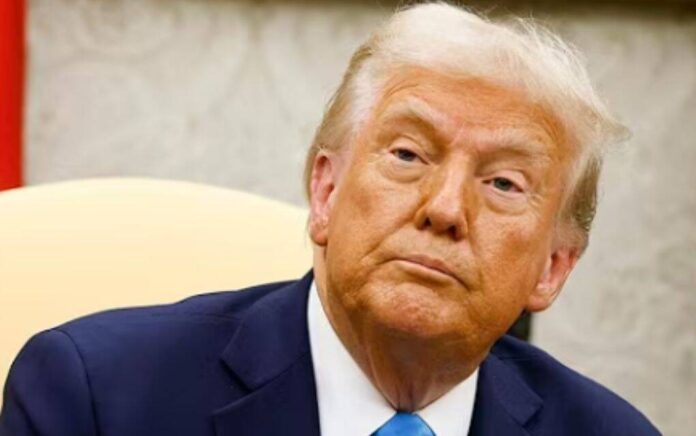
Illegal immigration has been issue number one for the new administration. Something unexpected just took place, though.
That’s why President Trump was taken aback by strange border crisis update.
US Southern Border Sees Dramatic Drop In Border Crossings Under Trump Leadership
From the perilous jungles of Panama to the arid landscape along the Texas-Mexico border, the once-bustling pipeline for illegal migration into the U.S. has experienced a sudden and significant slowdown. According to reports from immigration enforcement officials, illegal migrant encounters have dropped drastically over the past few weeks, a trend many attribute to the return of Donald Trump to the White House and the implementation of his tough border security measures.
The decrease in illegal migration is especially striking in the Darien Gap, a treacherous 40-mile-wide stretch of jungle that serves as a primary transit route for migrants traveling from South America to the United States. Data from Panama’s National Migration Service shows a 94% drop in illegal crossings through the Darien Gap in January 2024 compared to the same month in 2023. While 34,839 illegal migrants passed through the region last January, that number plummeted to just 2,158 in January 2024 following Trump’s return to office.
Panamanian citizen Allan Baitel attributed the decline to the increasing likelihood of deportation for migrants attempting to cross the Darien Gap. “I would say that people are less inclined to go through the Darien when they know very well that they’re going to end up shipped back home,” he told reporters. “So the carrot has disappeared, and there’s no reason for them to head north.”
The Darien Gap had long been a key hotspot for illegal migrants seeking to reach the United States, particularly under President Joe Biden’s administration, when migrant encounters at the U.S.-Mexico border surged. In 2023, more than half a million migrants traversed the Darien Gap, marking a historic high for illegal border crossings.
This vast jungle region, often fraught with organized crime and dangerous conditions, has historically been a difficult area to control. While many of the migrants crossing the Darien Gap are Latin Americans, including large numbers of Venezuelans and Ecuadorians, the route has also been used by migrants from Africa and Asia.
Smugglers capitalized on the migration route, making billions of dollars in profits. These criminal syndicates, which have smuggled migrants through the Darien all the way to the U.S. southern border, reportedly earned up to $14 million per day from their illicit activities.
For Venezuelan migrants, the Darien Gap had been a popular route, especially after the Venezuelan government refused to accept deportation flights from the U.S. However, Trump’s administration was able to successfully negotiate with the Venezuelan government, prompting Caracas to once again accept the repatriation of Venezuelan nationals. This development has further deterred migrants from taking the dangerous journey.
The reduction in illegal migration through the Darien Gap coincided with other border security efforts. One of these was a significant visit by U.S. Secretary of State Marco Rubio to Panama, where he secured a major infrastructure deal with President Raul Mulino. This agreement, in part, was aimed at reducing Chinese influence in the region and bolstering efforts to curb illegal immigration.
Mulino, who was elected in 2024, made a campaign promise to reduce migration through Panama. His administration entered into a deal with the U.S. to assist with the repatriation of illegal migrants caught by Panamanian authorities. “He’s always been pro-U.S.,” Surse Pierpoint, a third-generation Panamanian, shared with reporters. “And the fact that Marco Rubio’s first trip down here was the administration staking a claim that ‘this is Monroe Doctrine 2.0, stay out of our neighborhood.’”
During Rubio’s visit, he witnessed the deportation of Colombian nationals who had been detained by Panamanian authorities. The U.S. State Department emphasized that these repatriation flights act as a major deterrent for other would-be illegal migrants.
In addition to the drop in crossings through the Darien Gap, illegal migrant encounters along the U.S.-Mexico border have also seen a significant decline. On January 29, Border Patrol Chief Mike Banks reported a 55% decrease in migrant apprehensions from the previous week, attributing the trend to enhanced border security measures. “With more boots on the ground, we’re making a substantial impact to the security of our borders,” Banks said.
The Texas Department of Public Safety (DPS) also confirmed a consistent decline in migrant encounters, with only 446 illegal crossings reported on a recent Monday. For context, more than 12,600 unlawful crossings occurred in a single day in December 2023. This sharp decrease in illegal border activity follows the broader trend of a decline in illegal crossings along various sectors of the U.S.-Mexico border, including El Paso, Rio Grande Valley, and Big Bend.
“The State of Texas has experienced a decrease in illegal border crossings,” said Chris Olivarez, a DPS spokesperson. “In January 2024, Texas decreased illegal border crossings by 85%.”
Olivarez credited the reduction in crossings to Governor Greg Abbott’s Operation Lone Star, a border mission that involves deploying Texas National Guard soldiers and DPS personnel to bolster border infrastructure and target criminal smugglers. The initiative, along with stricter immigration policies at the federal level, has contributed to a significant decline in illegal border crossings across the southwest U.S., including Texas, Arizona, and California.
Since taking office, Trump has rolled out a series of reforms and initiatives aimed at strengthening border security and ensuring the swift detention and deportation of illegal migrants. These measures have included the deployment of troops to the border, the deputization of federal agencies to enforce immigration laws, and the creation of detention facilities outside of the U.S.
One of Trump’s key tactics has been using the threat of tariffs to pressure neighboring countries into cooperating with U.S. border security efforts. This strategy successfully led to Mexican President Claudia Sheinbaum deploying 10,000 members of her national guard to help secure the U.S.-Mexico border. Similarly, Canada’s Prime Minister Justin Trudeau agreed to enhance border security in exchange for avoiding tariffs on Canadian exports.
The U.S.-Canada agreement introduced several new initiatives, such as the appointment of a fentanyl czar, designating cartels as terrorist organizations, and allocating $200 million to combat organized crime and drug trafficking along the northern border.
As Trump’s re-election victory signaled a shift toward tougher immigration enforcement, many migrants have chosen to turn back rather than face the likelihood of being caught and deported. Baitel, the Panamanian citizen, explained, “The number of people arriving at the border is less, and I think Colombia, Venezuela, realize they have to reorganize themselves, and that there’s a new sheriff in town in the United States, and things are going to change.”
The Federalist Wire will update you on any major illegal immigration updates from the Trump administration.



















